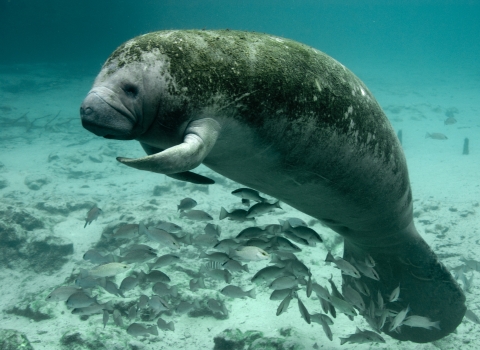WASHINGTON – The Department of the Interior announced that more than $46.2 million in grants was approved by the Migratory Bird Conservation Commission today, which will conserve or restore 91,425 acres of wetland and associated upland habitats for waterfowl, shorebirds and other birds in 17 states. These grants, made through the North American Wetlands Conservation Act (NAWCA), will be matched by more than $99.1 million in partner funds.
In addition, the Commission approved more than $11.7 million from the Migratory Bird Conservation Fund, providing the U.S. Fish and Wildlife Service and its partners the ability to conserve habitat on seven national wildlife refuges across seven states. The acquisitions will expand public opportunities for hunting, fishing, wildlife observation and outdoor recreational access.
“Investing in wetland conservation is an investment in the health of our environment and our economy. These grants will preserve essential habitats for migratory birds and boost local economies through enhanced recreational opportunities,” said Secretary Deb Haaland. “Today's announcement demonstrates our commitment to the Biden-Harris administration’s America the Beautiful initiative by conserving America's lands and waters that support biodiversity, protect communities from climate change climate change
Climate change includes both global warming driven by human-induced emissions of greenhouse gases and the resulting large-scale shifts in weather patterns. Though there have been previous periods of climatic change, since the mid-20th century humans have had an unprecedented impact on Earth's climate system and caused change on a global scale.
Learn more about climate change , and foster resilience for future generations.”
The Migratory Bird Conservation Commission is chaired by the Secretary of the Interior and authorized under NAWCA. The Commission has helped conserve much of the nation’s most important waterfowl habitat and establish or enhance many of the country’s most popular destinations for waterfowl hunting and birding.
“Across the country, migratory birds and their habitat are at risk due to drought, warmer temperatures and rising seas, said Service Director Martha Williams. “Projects supported through these grants help bolster wetland biodiversity and increase habitat for billions of migrating birds while expanding outdoor recreation opportunities for surrounding communities.”
North American Wetlands Conservation Act
NAWCA is the only federal grant program dedicated to the conservation of wetland habitats for migratory birds. Since 1991, over 7,000 partners have received more than $2.28 billion in grants for roughly 3,300 projects. Those partners have contributed another $4.53 billion in matching funds to improve more than 32.6 million acres of habitat, totaling more than $6.8 billion for wetland conservation that also benefits people, birds and other wildlife. Through NAWCA, federal funds are typically leveraged at twice the legally required dollar-for-dollar match ratio. Partners in NAWCA projects include private landowners, state, Tribal and local governments, conservation organizations, sporting groups, land trusts and corporations.
The Commission also received a report today on 22 NAWCA small grants, which were approved by the North American Wetlands Conservation Council in March 2024. Small grants are awarded for projects up to $250,000 to encourage new grantees and partners to carry out smaller-scale conservation work. The Commission has authorized the Council to approve these projects up to $5 million. This year, more than $4.7 million in grants was matched by more than $10 million in partner funds.
More than half of Endangered Species Act listed species rely on wetlands for essential habitat. The NAWCA funding will benefit 11 ESA listed bird species and 68 species identified as Birds of Conservation Concern, which helps prevent species from being listed.
More information on these NAWCA grants is available on the Service’s website.
Migratory Bird Conservation Fund
The funding to conserve 3,268 acres for seven national wildlife refuges through the Migratory Bird Conservation Fund was derived primarily from the sale of Federal Migratory Bird Hunting and Conservation Stamps, commonly known as Duck Stamps, and import duties on imported arms and ammunition. Since 1934, the Federal Duck Stamp Program has provided more than $1.2 billion for habitat conservation in the National Wildlife Refuge System.
These funds will be used to purchase waterfowl habitat at the following national wildlife refuges:
- Bear River Watershed Conservation Area, Idaho – $610,000 for 656 acres
- Big Muddy National Fish and Wildlife Refuge, Missouri – $2,940,000 for 294 acres
- Blackwater National Wildlife Refuge, Maryland – $1,577,000 for 460 acres
- Hackmatack National Wildlife Refuge, Illinois – $940,000 for 180 acres
- Panther Swamp National Wildlife Refuge, Mississippi – $3,095,000 for 938 acres
- Rappahannock River Valley National Wildlife Refuge, Virginia – $1,797,000 for 376 acres
- Trinity River National Wildlife Refuge, Texas – $840,000 for 364 acres
While Duck Stamps are required for waterfowl hunters as an annual license, anyone can contribute to conservation by buying them. A current Federal Duck Stamp is also a pass into any national wildlife refuge national wildlife refuge
A national wildlife refuge is typically a contiguous area of land and water managed by the U.S. Fish and Wildlife Service for the conservation and, where appropriate, restoration of fish, wildlife and plant resources and their habitats for the benefit of present and future generations of Americans.
Learn more about national wildlife refuge that charges an entry fee. Because nearly all the proceeds are used to conserve habitat for birds and other wildlife, outdoor enthusiasts including birders and nature photographers buy Duck Stamps to help preserve some of the most diverse and important wildlife habitats in our nation.
Additional information about North American wetlands and migratory bird conservation can be found on the Service’s webpage.



